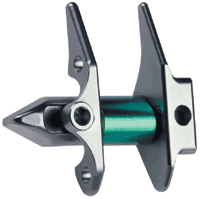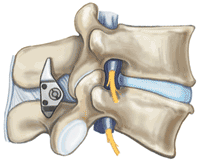FDA vote: Interspinous distraction device not recommended for approval
Developers of the titanium device that treats patients with mild to moderate lumbar spinal stenosis will challenge the vote.
GAITHERSBURG, Md. — The Orthopaedic and Rehabilitation Devices Panel of the Food and Drug Administration voted 5-3 against recommending approval of a novel interspinous spacer that treats mild to moderate lumbar spinal stenosis.
Panel members said the data in the premarket approval application (PMA) failed to demonstrate that using the device would provide significant improvement for a majority of patients or that it would modify physical features of the stenotic spine, as was seen during cadaver studies. Indications were also too broad.
The panel indicated that St. Francis Medical Technologies Inc., Concord, Calif., manufacturer of the X-Stop implant, had insufficient radiographic evidence demonstrating the efficacy of the implant. Other data were also needed to prove the device’s efficacy with reasonable assurance, including longer follow-up of up to three years, panelists said.
“There was no assessment of objective radiographic criteria that could answer to my complete satisfaction that the process that you were trying to prove existed really happened,” said neurosurgeon Fernando G. Diaz, MD, PhD, of Detroit, in closing comments.
Inconsistent outcomes
|
COURTESY OF ST. FRANCIS MEDICAL TECHNOLOGIES |
In addition, panel members questioned whether the effect seen in the patients randomized to receive the implant could be delivered consistently to all patients for whom the X-Stop device is indicated. Results with the device were considerably better at St. Mary’s Spine Center in San Francisco where the X-Stop’s inventor, James F. Zucherman, MD, was the investigator.
Success rates were 85% vs. 13.3% to 50% at the other centers. “There shouldn’t be that huge difference between the designer and developer and the rest of the people,” Diaz said.
Choll W. Kim, MD, PhD, panel member and an orthopedic surgeon at the University of California-San Diego, voted to recommend its approval. “This device offers important options in the treatment of that patient with spinal stenosis who wishes to avoid the general anesthesia and potential risk of laminectomy,” he said.
He suggested the data be further analyzed to address potential biases that arose either during randomization or at the inventor’s center.
“The X-Stop is a very innovative device,” said Gunnar B. Andersson, MD, PhD, during his closing summary for St. Francis Medical. “It is unusual in the sense that it addresses the problem within the spinal canal without entering the spinal canal. It’s also unusual in the sense that it leaves the door open for additional procedures should they be necessary,” said Andersson, a member of the Orthopedics Today Editorial Board’s basic science and research section.
The titanium X-Stop device is implanted through a minimally invasive procedure, usually under local anesthesia, and is placed between the spinous processes of one or two lumbar levels affected with mild or moderate neurogenic intermittent claudication secondary to lumbar spinal stenosis (LSS). It is indicated for patients at least 50 years old who have leg, buttock and/or groin pain with or without back pain, and who have failed nonoperative treatments.
Since the device limits lumbar extension, developers said it is suited for those patients who find relief in flexion, such as when sitting.
Success rates compared
One hundred ninety-one patients with mild to moderate LSS were enrolled and block randomized at each of nine centers to the treatment group (100) or to a control group that received nonoperative therapy consisting of epidural injections (91). The standard treatment for mild to moderate LSS is nonoperative care.
Follow-up assessments were done with the Zurich Claudication Questionnaire (ZCQ), SF-36, physical examinations and, in some cases, radiographs at six weeks and at six, 12 and 24 months. Adverse events were minimal.
At the 24-month follow-up, 58% of patients in the treatment group had clinically significant improvement in symptom severity vs. 17% in the control group. Physical function improved significantly in 55% of treated patients vs. 14% in the control group. Using all three domains of the ZQC, 46.9% of patients who received the X-Stop implant met success criteria vs. 4.6% in the control group (P<.001).
Panel members voiced concerns about the study’s execution since eight patients who received the X-Stop implant also received epidural injections postoperatively. Also, primary reliance on the subjective ZCQ questionnaire concerned some on the panel.
“While verified in the cadaver model, the concept of preventing the narrowing of the canal, lateral recess and foramen was not verified in the clinical study,” said John S. Kirkpatrick, MD, lead clinical reviewer.
Strongly disagree
St. Francis Medical Technologies officials said in a statement issued the day after the panel met that it strongly disagrees with the panel’s recommendation and is “in the process of scheduling a meeting with FDA to discuss the panel members’ comments and recommendations and the steps necessary to resolve the questions that were raised during the meeting.”
The firm’s PMA application was filed in early January and given an expedited review in late February.
Dr. Andersson has a financial interest in the product mentioned in this article.


